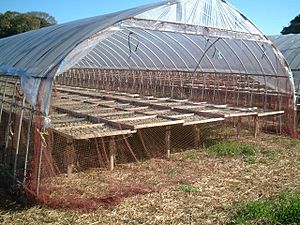Hoshi-imo facts for kids

drying hoshiimo in a polytunnel
|
|||||||
| Place of origin | Japan | ||||||
|---|---|---|---|---|---|---|---|
| Invented | 19th century | ||||||
| Main ingredients | Sweet potatoes | ||||||
| 236-311 kcal (-1066 kJ) | |||||||
|
|||||||
| Glycemic index | 55 (low) | ||||||
| Similar dishes | whole roasted unskinned sweet potatoes (yaki-imo) | ||||||
Hoshiimo (干し芋) is a yummy sweet potato snack from Japan. It's a lot like other dried foods you might find in Asia.
To make hoshiimo, sweet potatoes are usually steamed, then peeled and sliced. After that, they are dried. No extra sugar or artificial sweeteners are added. Sometimes, the sweet potatoes are roasted instead of steamed.
You might see a white powder on the outside of hoshiimo. Don't worry, it's not mold! It's just natural sugar that has come to the surface and crystallized as the sweet potatoes dried.
Hoshiimo has a chewy texture and a sweet potato taste. You can eat it as it is, or you can roast it a little. This snack is full of good things for you, like vitamins A, B1, C, and E. It also has lots of potassium, calcium, and dietary fiber.
Contents
Other Names for Hoshiimo
In Japan, hoshiimo is also known by other names. These include 'kanso-imo' (乾燥芋), 'mushi-kirihoshi' (虫霧干), and 'kiriboshi kansho' (切干甘藷).
You can find similar dried sweet potato snacks in other countries too. In Korea, there are two dishes called "goguma-malaengi" (고구마말랭이) and "mallingoguma" (말린고구마). "Mallingoguma" is usually cut into thinner slices, making it a bit crispier.
China has a snack very similar to hoshiimo called "dìguā gàn" (地瓜干). In Vietnam, a similar product is known as "khoai lang sấy dẻo".
Different Kinds of Hoshiimo
In Japan, hoshiimo comes in many different shapes. Some look like French fry rods. Others are broad, flat pieces, about 10–15 centimeters long and 5 centimeters wide. You can also find whole, unsliced hoshiimo, which are called "maru-boshi" (丸干し).
Sweet Potato Varieties Used
Many kinds of sweet potatoes are used to make hoshiimo. Some common types include Beniharu (紅はる), Tamayutaka (玉豊), Silk Sweet (シルクスイート), and Anno-Mitsuki (安納蜜嬉).
Did you know that China grows more sweet potatoes than Japan? Also, sweet potatoes are often cheaper in China. Because of this, a lot of the hoshiimo sold in Japan today is actually made in China.
The History of Hoshiimo
Hoshiimo is thought to have started in Omaezaki City, which is now part of Shizuoka Prefecture in Japan. Around 1824, a merchant named Shozo Kuribayashi began making this snack in small amounts.
Making Hoshiimo for Everyone
Later, in 1892, two people named Rinzo Ohniwa and Jinhichi Inagaki improved how hoshiimo was made. This made it easier to produce a lot of it for many people. Soon, hoshiimo became a popular preserved food all over Japan.
During the Russo-Japanese War, hoshiimo was even used as a food for soldiers. People sometimes called it "soldier's potatoes" back then.
Ibaraki Prefecture's Role
Large-scale production of hoshiimo began in Ibaraki Prefecture in 1908. There are two main ideas about how hoshiimo came to Ibaraki.
One idea is that a rice cracker maker named Toshichi Yuasa hired a special technician. This technician changed Yuasa's dried seafood factory to make hoshiimo instead.
Another idea is that Seiji Koike and Jizan Ouchi got help from the governor of Ibaraki Prefecture, Masataka Mori. They started local production with the help of two technicians from Shizuoka.
Both government groups and private businesses in Ibaraki Prefecture have worked hard to promote hoshiimo. In 2019, the Hitachinaka Chamber of Commerce and Industry won an award for their "Dried Sweet Potato Attraction Project." This project included making hoshiimo cakes and a book about its history.
Today, more than 80% of all the hoshiimo sold in Japan comes from Ibaraki Prefecture!

